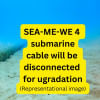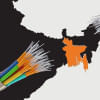Push for the third submarine cable

With existing internet bandwidth likely to be exhausted next year, the government is in talks with a consortium for a third undersea cable connection.
The demand for internet bandwidth almost doubled in the last one year, to 1,000 gigabits per second (Gbps) from 550 Gbps of late 2017. And experts fear the country could run out of bandwidth even sooner.
They say Bangladesh needs to act fast or else it would have to depend heavily on import from India.
But the third connection is going to cost the country a pretty penny and will not happen until 2022.
Bangladesh paid Tk 500 crore for its first undersea connection (SEA-ME-WE 4) in 2006. Myanmar shared the cost of a branch line for Bangladesh's second undersea cable connection (SEA-ME-WE 5) in 2017 but it still cost the country Tk 650 crore.
The third cable Bangladesh wants to connect to is going to be further out into the Bay of Bengal than the first two, which will jack up the branch line cost. Furthermore, Myanmar this time is showing little interest in getting connected with the cable (SEA-ME-WE 6).
Bangladesh is trying to get the cable closer to its shores so that the cost of the branch line is less, said an official of state-run Bangladesh Submarine Cable Company Ltd (BSCCL) which meets lion's share of the country's internet demand.
The top brass of BSCCL said on January 18 the consortium members of SEA-ME-WE 6 met in Singapore, where representatives of China Telecom Global, China Telecom, True Thailand, Ni2i of Mauritius, and companies from Singapore, India, Sri Lanka, and Saudi Arabia were present.
BSCCL did not attend the meeting but they have been in touch with the consortium via phone and email. Things were in the preliminary stage and if everything went well, Bangladesh would be connected by 2022, said a BSCCL source.
Telecom and ICT Minister Mustafa Jabbar said definitely cost would be considered but at the same time the country needs to consider the growing demand.
“More and more new technologies are hitting the market, fuelling growth in data consumption,” he said.
The minister said the growth rate was flying and Bangladesh would exhaust its bandwidth capacity within the next year. It would not be possible for the BSCCL to meet demand unless an alternative source of internet was in place, Jabbar said.
“For the next one, we will get huge bandwidth. I am not sure but it might have 10 Tbps [terabit per second] of ultimate capacity, and we can then look into exporting bandwidth to neighbouring landlocked countries as well.”
The cable's capacity is usually determined by the ability of the equipment used for transmitting and receiving data through it. The equipment can be upgraded to obtain more bandwidth until the cable's ultimate capacity is reached.
Jabbar said in October last year, ICT adviser to the prime minister Sajeeb Wazed Joy also opined that a third undersea connection was needed.
Mashiur Rahman, managing director of the BSCCL, said the government is very serious about the country's third submarine cable and the BSCCL is looking into several options for undersea connectivity.
Industry insiders said the introduction of 4G mobile services in Bangladesh helped push the bandwidth demand into 1,000 gigabits per second (Gbps) from 550 Gbps of late 2017. Demand from users of wired broadband internet had been increasing as well, they said.
As carriers are now prepping for 5G in the developed world, it will not be too long before the fifth-generation mobile internet service is made available in Bangladesh, sources said.
Another reason for considering the third submarine cable is that the first cable is nearing the end of its 20-year life, said a BSCCL official.
“It is not possible to expand the capacity of the first undersea cable much and its maintenance cost is also increasing every year,” the official said.
With the two existing cables, the BSCCL can deliver 1,800 Gbps but is actually using about 650 Gbps. Bandwidth imported from India is used for meeting the rest of the demand.
BSCCL also exports about 10 Gbps to eastern parts of India.
“Import of bandwidth from India is gradually decreasing as our undersea cables are supplying plenty of bandwidth,” said BSCCL MD.
Where the third cable would land is yet to be decided. The first cable landed in Cox's Bazar and the second one in Kuakata.
Sumon Ahmed Sabir, chief technology officer of Fiber@Home, the leading wholesale bandwidth supplier in the country, said the country was moving towards digitalisation and that was why data use grew so much in the last few years.
“People are now watching more and more video content and that's why they are consuming so much data.”
He, basing it on trend, predicted that Bangladesh would be using 2,000 Gbps this year. Bangladesh is very late in deciding to join a third submarine cable, said Sabir.
Sri Lanka is a small country but it is connected to six cables and the SEA-ME-WE 6 will be their seventh and it will not face scarcity of bandwidth in decades, said a market analyst.
Bangladesh has around 9.13 crore internet accounts as of December 2018, according to Bangladesh Telecommunication Regulatory Commission (BTRC).
According to the BTRC, there are 59 lakh broadband internet connections and internet service providers claim that these 59 lakh connections consume 70 percent of the total bandwidth.
Google says Bangladesh has about 3.5 crore unique internet users.

 For all latest news, follow The Daily Star's Google News channel.
For all latest news, follow The Daily Star's Google News channel. 








Comments